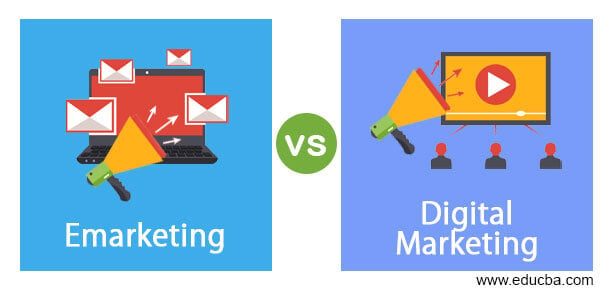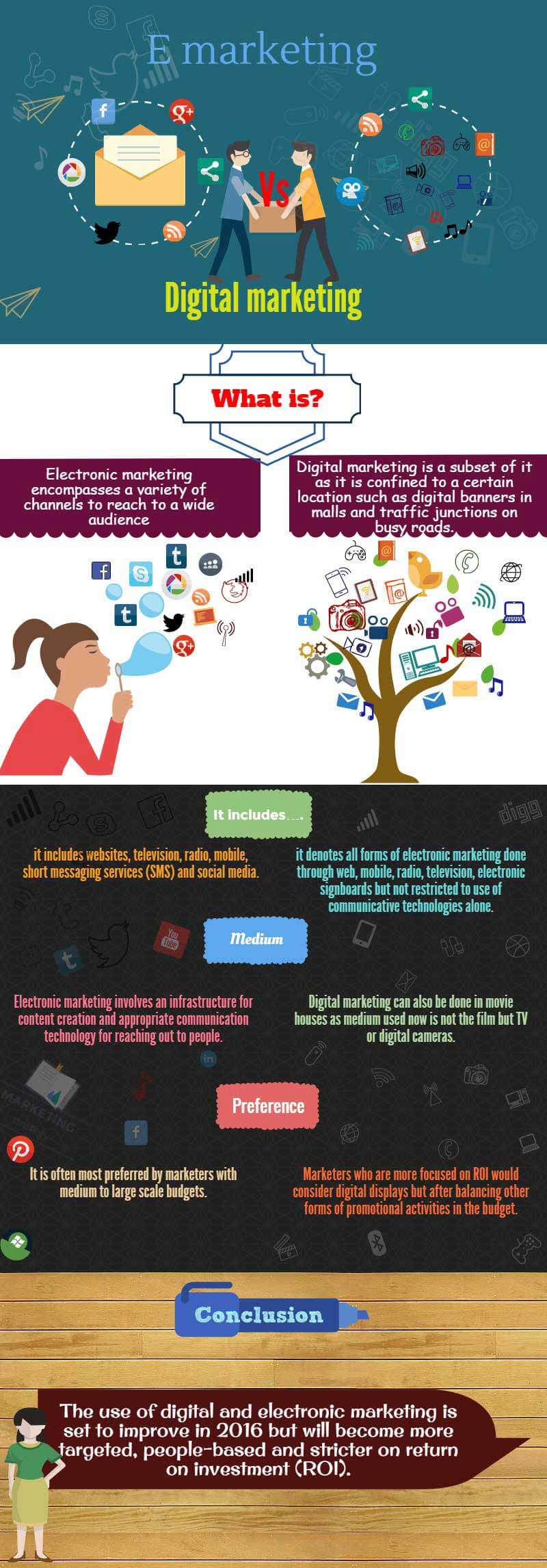
Difference Between Emarketing vs Digital Marketing
The following article provides an outline for Emarketing vs Digital Marketing. With the advances in technology and communications and their varied applications in everyday life, it has become difficult to define specific terms. It cannot possibly go by its literal meaning. For example, telemedicine doesn’t mean consulting a physician over the telephone. Still, it is more broad-based to include transmission of text, images, and videos of a patient living through satellite or broadband to an expert sitting at a different location and diagnosing the disease or ailment.
Likewise, electronic marketing (Emarketing) denotes television and radio channels that transmit/broadcast programs to a large audience. Still, it would not include those viewing a film on CD at home or in a theatre. Although in a technological sense, all these applications are based on Emarketing.
Emarketing vs Digital Marketing Infographics
Below infographics on Emarketing vs Digital Marketing illuminate the major differences between the two marketing streams.
In a technological sense, Emarketing denotes the use of integrated circuits, resistors, transformers, and relays mounted on printed circuit boards. However, digital is narrower because it relates to information technology and assembly-level programming involving binary digits, zeroes, and ones (0 & 1).
Emaketing and digital technologies have numerous overlapping and interconnected applications instead of being compartmentalized.
The distinctions between E-marketing, digital marketing, and digital media are becoming increasingly ambiguous in the marketing world. However, when viewed from an academic or practical perspective, understanding the communication technology used or not used can provide new insights into the nuanced differences between Emarketing and digital marketing. Emarketing, mobile technology, digital, and internet marketing seems to be used interchangeably by various writers and experts.
Here is an attempt to highlight the subtle differences in these terminologies to clarify their scope, uses, and limitations.
Emarketing
Emarketing encompasses a variety of channels to reach a broad audience, including websites, television, radio, mobile, short messaging services (SMS), and social media. Emarketing presupposes a broad audience, a democratic medium accessible to all. Transmission could be through wired networks, radio waves, satellites for long-distance TV and radio transmission, and wireless networks (WiFi) for internet and mobile net access.
Emarketing marketing involves an infrastructure for content creation and appropriate communication technology for reaching out to people.
Developing content for television and radio requires a studio, recording equipment, human resources, and technical personnel to manage the recording equipment and transmission, in addition to outsourcing software programs for entertainment and information.
Due to the democratic nature of the medium, its accessibility, and reach, Emarketing media such as television, radio, and websites are often most preferred by marketers with medium to large-scale budgets.
Advertising sustains the operations of many Emarketing media, as only a tiny fraction relies on subscription-based revenue models. Television and radio offer several options for advertisers to reach a vast audience. It could be through sponsorship of programs or putting 30-sec 65-second commercials in-between popular programs.
In tune with the reach of the medium, charges are also relatively high in Emarketing media and appear most suitable for brand building for home appliances, Emarketing goods, processed food, cooking materials, fashion, automobiles, cosmetics, toiletries among others, and less ideal for heavy machinery, equipment, technology industry, and Business to Business (B2B) sectors.
Women, children, and the elderly are large audiences for television and radio, while men may be more inclined towards sports, news, and movies. One may recall that in the 1990s, the sudden surge in popularity and reach of Emarketing media had reduced the ad market share of newspapers, magazines, and other forms of print media.
If radio and television had consumed traditional media’s market share, the internet’s rapid penetration in the last decade has removed some of the businesses from traditional print and Emarketing media. The number of internet users globally now runs into billions, and the growth of mobile telephony has taken the popularity of browsing and social media to newer heights.
The websites offer display advertisements at the top and bottom, known as headers and footers, and also in ear panels and mainly on the right-hand side of the pages. Display advertising, especially on homepages, is quite costly, and marketers must examine its cost-benefit before committing to a budget.
Some websites offer text link ads, which they place within the text or at the end of an article. These ads are usually more clickable than display advertisements. It has been found that visitors to a website are eager for information, data, or pictures and, depending on internet speed, are more interested in accessing content rather than clicking on display ads that may contain high-resolution pictures with or without animation or videos.
Google places ads on web pages or search pages with the most relevant content related to our product or service, increasing the likelihood of people opening them. Therefore, Google ads are a more reliable and result-oriented way of reaching a larger audience. On the web, ad rates are typically based on either cost per click (CPC) or cost per impression (CPM), with the minimum unit being a thousand impressions. Displaying an ad on the desktop or mobile phone screen does not guarantee that it will be read and acted upon. Hence, this may be why advertisers now prefer CPC ads to CPM or fixed-rate display ads. CPC and CPM rates vary on the popularity of the site, the keywords, and how competitive it is.
Companies could opt for display ads if the objective is for brand building and not expecting immediate sales conversion or booking.
Mobile devices also offer opportunities to reach a large audience, and the most popular, cost-effective strategy is short messaging services (SMS). A bulk SMS platform is a cost-effective way to reach a large audience anywhere. However, bulk SMS has limitations, such as only being effective for numbers not on the do-not-disturb (DND) list. Stricter regulations from telecom regulators on calls or messages sent to numbers registered in the do-not-disturb (DND) list are increasingly limiting the reach of bulk SMS marketing. Moreover, the clever use of words, the timing of the message, and selecting the right target audience can result in a better return on investment (ROI).
Email marketing, until recently, was considered an excellent strategy to reach a targeted audience, but now, with Google differentiating emails into primary, promotion, and social, the receiver has the option to avoid promotional emails if they don’t wish to see them. Sending frequent spam messages puts individuals at risk of having their messages diverted to recipients’ spam boxes, where automated systems are likely to delete them without being read.
Digital Marketing
There are two ways of looking at digital marketing. For some experts and analysts, it denotes all forms of Emarketing marketing done through web, mobile, radio, television, and Emarketing signboards but not limited to communicative technologies alone.
Some people argue that Emarketing is a broader category than digital marketing and that digital marketing is a subset of it, limited to specific locations like digital banners displayed in malls or at traffic junctions on busy roadsDigital marketing can also make use of movie theaters, as the medium used nowadays is TV or digital cameras instead of film. Or the other option is to classify as online digital promotion and offline digital promotion activities.
The rapid development of Light Emitting Diodes (LED) technology has enabled places with large footfalls to put up LED Wall displays for advertising. It could be a mall, a hypermarket, a busy junction, railway stations, airports, and even buses and trains.
With municipality and city authorities clamping down on flex boards and banners due to allegations regarding environmental pollution and distraction to motorists, digital banner displays have emerged at the forefront due to their environmental friendliness and lesser distractive influences. LED technology now lends itself to textual messages, images, animation, and video, thus appealing to more and more marketers. Event organizers now widely use them in events, exhibitions, and trade fairs, where many visitors converge, including consumers and businessmen.
The availability of strategic positions on roadways, malls, and hypermarkets, rental costs, and maintenance costs will be the factors that influence the widespread use of digital displays in the coming years. Marketers more focused on ROI would consider digital displays after balancing other promotional activities in the budget.
To capture the audience’s interest, digital marketing must constantly evolve and adopt new attention-grabbing techniques, as digital displays are often placed in areas where people are involuntarily exposed to them, such as traffic junctions, malls, cinema theaters, trade fairs, and events.
Digital displays without communicative technologies and based on location will have an advantage over flex and metal hoarding displays in distracting public places due to improved technologies and movement.
Conclusion
In 2016, businesses expected marketing professionals to increase their usage of digital and e-marketing techniques, specifically targeting individual customers, measuring ROI, and achieving better outcomes. When digital marketing is seen as all-encompassing, including online and offline, it is predicted that marketers will be under increased pressure to solve challenges such as getting a clear view of the customer across disparate data sources, connecting the past to a customer’s intent, and demonstrating attribution and ROI, according to Signal.
The Adblockers in websites and mobiles cost the publishing industry as much as $41 bn. As advertisers seek to target known audiences versus unknown ones, social media such as Twitter and Facebook are likely to increase their market share. Digital marketers will look at the mobile applications space more intensely, as 60% of the time spent on digital media is on mobile devices. Analysts predict advertisers will spend $42 billion on mobile ads, accounting for about two-thirds of all digital ad spending. The digital display ads market is over $27 bn, with social media (Facebook, Twitter) and Google accounting for 43% of the market share.
According to a US Survey, there is a vast difference in adoption levels of digital technology across industries. At the forefront of digital technology, adoptions are media, professional services, information and communications technology (ICT), and financial services. However, digital use is expanding in many labor-intensive industries, such as retail and healthcare. However, labor-intensive localized businesses, including real estate, agriculture, and construction, are less likely to adopt digital technology.
The survey pointed out that offline and digital technologies are merging. Therefore, keeping offline marketing relevant by using augmented reality to create interactive print, add measurability to campaigns, and drive sales is essential.
The trend drivers for 2016 for digital and marketing would be a great design, great experience, and a holistic experience. Customers now look forward to ‘experience-driven’ rather than ‘claims-driven’ campaigns and design elegance will be the factor that matters most.
Following the Uber design, customers will now be geared to great but minimalistic design features, whether it is on websites, mobile apps, digital display boards, and even in print. In 2016, customers expect marketers to recognize their needs and make the feel that they know them. Consumers desire personalized online shopping experiences, including apps that automatically populate content based on their interests, and they want to feel recognized as human beings.
The increased merger and acquisition activity in the digital space by companies such as Google, Facebook, Apple, Yahoo, Verizon, and Twitter highlights the importance of digital marketing. Digital M&A’s are expected to rise 24% in 2016.
Data would now decide the composition and design of digital marketing have driven decisions. As data mining and analysis of customers are becoming more widespread, the marketing focus is likely to turn customer-centered and related to their needs. Marketers will depend more on people with data science skills to understand the customer’s spending and buying behavior and what motivates them to create digital surprises.
In the US, a survey has indicated 82% of marketers will increase the use of data generated from customers to conceptualize campaigns.
Recommended Articles
We hope that this EDUCBA information on “Emarketing vs Digital Marketing” was beneficial to you. You can view EDUCBA’s recommended articles for more information,

